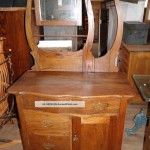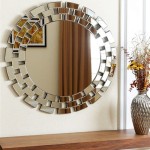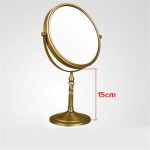Why Convex Mirrors Are Used In Vehicles
Convex mirrors are ubiquitous on vehicles, serving as essential components of safety systems designed to enhance driver awareness. Their prevalence stems from their unique optical properties that offer a broader field of view compared to flat mirrors, albeit with some inherent limitations in depth perception. This article will explore the specific reasons behind the widespread adoption of convex mirrors in vehicles, focusing on their advantages, disadvantages, and the overall contribution they make to road safety.
The fundamental reason for employing convex mirrors lies in their ability to reflect light from a wider area. The outward curvature of the mirror’s surface allows it to capture light rays emanating from a larger angle relative to the driver. This expanded field of view is crucial for minimizing blind spots, particularly those that are difficult or impossible to eliminate using only flat mirrors. A driver can observe more lateral space behind the vehicle, improving their ability to safely change lanes, merge onto highways, and navigate complex traffic situations.
Improved Field of View and Blind Spot Reduction
Blind spots represent a significant hazard for drivers. These areas, located to the sides and slightly behind the vehicle, are obscured from the driver’s direct line of sight and even from standard flat mirrors. Convex mirrors mitigate this issue significantly. The wider angle of reflection effectively "stretches" the driver's peripheral vision, revealing vehicles and other objects that would otherwise be hidden. This is particularly important on multi-lane highways or in urban environments with heavy traffic density. The increased awareness provided by convex mirrors allows drivers to make more informed decisions about maneuvering their vehicle, drastically reducing the risk of collisions.
Consider a scenario where a vehicle is attempting to merge onto a highway. Without convex mirrors, the driver might only have a limited view of the adjacent lane, potentially missing a speeding vehicle approaching from behind. A convex mirror, however, would provide a much broader perspective, allowing the driver to accurately assess the speed and distance of other vehicles and execute the merge safely. This advantage is not limited to highway driving; parallel parking, navigating narrow streets, and even backing out of parking spaces are all made considerably safer with the enhanced visibility offered by convex mirrors.
The strategic placement of convex mirrors on vehicles is also a key factor in their effectiveness. Typically, they are positioned as side-view mirrors or incorporated into the design of side-view mirrors alongside a flat mirror portion. This allows the driver to utilize both types of mirrors for different purposes, leveraging the strengths of each. The flat mirror provides an accurate representation of distance, while the convex mirror compensates by providing a wider angle of coverage. Some vehicles also use smaller convex mirrors as "spot" mirrors, attached to the main side mirrors and angled to further minimize blind spots.
The Trade-Off: Distance Distortion
While the extended field of view is a significant advantage, it comes at the cost of accurate distance perception. Convex mirrors, by their nature, compress the image, making objects appear farther away than they actually are. This distortion is a direct consequence of the reflection from the curved surface. Because the light rays are dispersed over a wider area, the brain interprets the image as being more distant. This inherent limitation is why nearly all convex mirrors are accompanied by a warning, such as "Objects in mirror are closer than they appear."
Drivers must consciously account for this distortion when using convex mirrors. Relying solely on the mirror to judge the distance of following vehicles can lead to miscalculations, potentially resulting in unsafe maneuvers. Experienced drivers learn to compensate for this distortion through practice and by cross-referencing the information provided by the convex mirror with visual cues and other mirrors. However, new drivers and those unfamiliar with the vehicle may find it challenging to accurately judge distances initially. This emphasizes the importance of driver education and awareness regarding the limitations of convex mirrors.
Despite the distance distortion, manufacturers continue to employ convex mirrors due to the overwhelming benefits of increased visibility. The trade-off between distance accuracy and a wider field of view is considered acceptable, provided drivers are aware of the distortion and adjust their driving accordingly. The risk of accidents caused by blind spots is generally considered greater than the risk associated with misjudging distance, especially when drivers are properly trained and attentive.
Legal Regulations and Safety Standards
The use of convex mirrors in vehicles is often mandated or regulated by government agencies and safety organizations. These regulations typically specify the curvature, size, and placement of the mirrors to ensure they meet minimum safety standards. The aim is to provide drivers with adequate visibility while also mitigating the potential for excessive distortion. These regulations vary by region and vehicle type, reflecting differences in traffic patterns, road conditions, and safety philosophies.
For example, some jurisdictions require that all passenger vehicles be equipped with both a flat mirror and a convex mirror on the driver's side, while others permit the use of a single mirror that incorporates both flat and convex sections. Regulations may also dictate the minimum field of view that the mirrors must provide, ensuring that drivers can see a sufficient area around their vehicle. These standards are continuously reviewed and updated as technology advances and new research emerges on the effectiveness and limitations of different mirror configurations.
The development of advanced driver-assistance systems (ADAS) is also influencing the role of convex mirrors. Many modern vehicles are equipped with features such as blind-spot monitoring systems, which use sensors to detect vehicles in blind spots and alert the driver. While these systems cannot entirely eliminate the need for convex mirrors, they can further enhance safety by providing an additional layer of protection. Integrating these technological advancements with traditional mirror systems represents a multifaceted approach to improving driver awareness and reducing the risk of collisions.
In summary, the widespread use of convex mirrors in vehicles is driven by their ability to significantly expand the driver's field of view and minimize blind spots. While they introduce some distortion in distance perception, the benefits of increased visibility are generally considered to outweigh this limitation, provided drivers are aware of the distortion and adjust their driving accordingly. Legal regulations and safety standards further regulate their use, ensuring a minimum level of safety. As technology continues to evolve, the role of convex mirrors may change, but their fundamental contribution to enhancing driver awareness and preventing accidents will likely remain significant for the foreseeable future.
Why Is A Convex Mirror Used Near The Driver S Seat In Motor Car Quora

Convex Mirror Image Formation S

Convex And Concave Mirrors In Cars

Why Do We Prefer A Convex Mirror As Rear View In Vehicles

Convex Mirrors Use Car
Why Is A Convex Mirror Preferred For Use As Driving Over Plane Quora

Concave Vs Convex Mirrors In Cars

Objects In Mirror Are Closer Than They Appear Wikipedia

The Reason Why Objects In A Car S Side View Mirror Are Closer Than They Appear Mental Floss
Why Is Convex Mirror Used In Vehicle Quora








